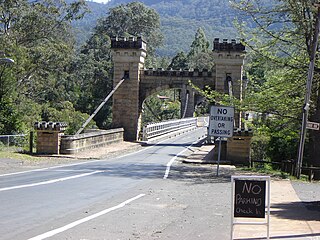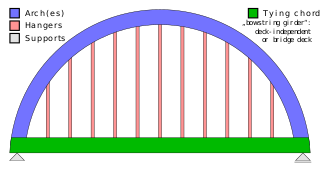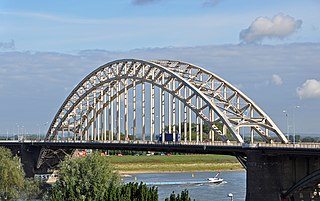
Nijmegen is the largest city in the Dutch province of Gelderland and the tenth largest of the Netherlands as a whole. Located on the Waal River close to the German border, Nijmegen is one of the oldest cities in the Netherlands and the first to be recognized as such in Roman times. In 2005, it celebrated 2,000 years of existence.

Arnhem is a city and municipality situated in the eastern part of the Netherlands, near the German border. It is the capital of the province of Gelderland, located on both banks of the rivers Nederrijn and Sint-Jansbeek, which was the source of the city's development.

The Waal is the main distributary branch of the river Rhine flowing approximately 80 km (50 mi) through the Netherlands. It is the major waterway connecting the port of Rotterdam to Germany. Before it reaches Rotterdam, it joins with the Afgedamde Maas near Woudrichem to form the Boven Merwede. Along its length, Nijmegen, Tiel, Zaltbommel and Gorinchem are towns of importance with direct access to the river.

Hampden Bridge is a heritage-listed single-span suspension bridge that carries Moss Vale Road (B73) across the Kangaroo River, in Kangaroo Valley, in the City of Shoalhaven local government area of New South Wales, Australia. The bridge was designed by Ernest de Burgh and built by Loveridge and Hudson. The property is owned by Transport for NSW. It was added to the New South Wales State Heritage Register on 2 August 2019.

A tied-arch bridge is an arch bridge in which the outward-directed horizontal forces of the arch(es) are borne as tension by a chord tying the arch ends rather than by the ground or the bridge foundations. This strengthened chord may be the deck structure itself or consist of separate, independent tie-rods.

The Hawkesbury River railway bridge is a heritage-listed railway bridge in New South Wales, Australia that carries the Main North railway line across the Hawkesbury River. The bridge crosses between Brooklyn on the northern outskirts of Sydney and Cogra Bay in the Central Coast region. The railway bridge was to be the last link in a railway network that linked the state capitals Adelaide, Melbourne, Sydney and Brisbane and was a major engineering feat at the time. The original railway bridge was built in 1889 and replaced by the current bridge in 1946. The 1946 bridge was added to the New South Wales State Heritage Register on 2 April 1999.
Jan Jozef Lambert van Hoof was a member of the Dutch resistance in World War II, who cooperated with Allied Forces during Operation Market Garden. He is credited with disabling explosives placed by the Germans to destroy a vital bridge to delay allied liberation, and was later executed in action. Before and during the war, Van Hoof was a Rover Scout, and the Scouting medal the Nationale Padvindersraad was named in his honour.

This is a list of bridges in the French city of Lyon on the Rhône and Saône rivers, ordered from upstream to downstream portions of the river.

The Waalbrug is an arch bridge over the Waal River in Nijmegen, Gelderland, the Netherlands. The full length of the Waalbrug is 604 metres (1,982 ft), the middle of the arch being about 65 metres (213 ft) high. The arch itself is 244.1 metres (801 ft) long and was the longest arch in Europe at the time of construction.

The Hindenburg Bridge was a railway bridge over the Rhine between Rüdesheim in the German state of Hesse and Bingen-Kempten state of Rhineland-Palatinate, named in 1918 after Field Marshal Paul von Hindenburg, later German President. The bridge was put in service in 1915, destroyed in the Second World War and never rebuilt.

The Maas–Waal Canal is a canal in the Netherlands that connects the river Meuse to the river Waal. The channel is about 13.5 kilometres (8.4 mi) long and runs from Weurt to the south and ends at Heumen. The connection of the Meuse and the Maas–Waal Canal is the tripoint between the provinces of Gelderland, Limburg and North Brabant.

The Hamm Railway Bridge carries the Mönchengladbach–Düsseldorf railway over the Rhine between the Düsseldorf suburb of Hamm and the Neuss district of Rheinparkcenter in the German state of North Rhine-Westphalia.

The Hammer Bridge is a 220 metres (722 ft) long railway bridge on the Weser Valley line crossing the Geul valley a few hundred meters to the south of Hergenrath.
Veur-Lent is the name of an island in the Dutch river Waal. It is part of the municipality of Nijmegen, situated in the Lent Quarter, north of both the city center and the main channel of the Waal.

The Worms Rhine Bridge is a two-track railway bridge that spans the Rhine river to the north of Worms, Germany, forming part of the Worms–Biblis railway.

Burdekin River Rail Bridge is a heritage-listed former railway bridge on the Great Northern railway over the Burdekin River at Dotswood, Charters Towers Region, Queensland, Australia. It was designed by Henry Charles Stanley and built from c. 1896 to 1899 by Swanson Brothers. It is also known as Macrossan Bridge. It was added to the Queensland Heritage Register on 21 October 1992.

The Battle of Nijmegen, also known as the Liberation of Nijmegen, occurred from 17 to 20 September 1944, as part of Operation Market Garden during World War II.

The Culemborg railway bridge is a tied-arch bridge in the Netherlands over the Lek, on the Utrecht–Boxtel railway.

De Oversteek, also called Stadsbrug, is a road bridge over the river Waal in the Netherlands. Opened in 2013, it is situated immediately to the west of Nijmegen city centre. The bridge has four traffic lanes, two in each direction, and a four metre wide shared pedestrian and cycle path.





















